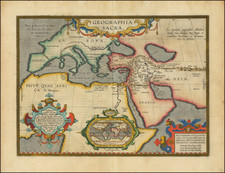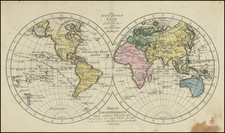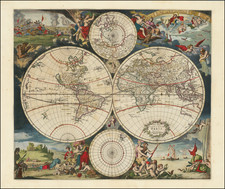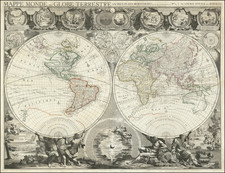First State of One of the Earliest Thematic Maps -- The First Thematic Map Focused on Zoology
Bound Into Zimmerman's Landmark 3 Volume Work on Biogeography
Rare map of the world showing the distribution of mammals or quadrupeds. As noted by Princeton's on-line exhibition on Thematic Mapping, Zimmerman's map is the:
first map of animal geography. . . It is the addition and geographical placement of the Latin names of quadrupeds that distinguishes the map from anything previously published. Castor (beaver), for example, appears throughout northern North America; leo (lion) in Africa; and kanguro (kangaroo) in northeastern Australia, where Cook's men first sighted one. Though very rudimentary in style and accuracy, the map marks an auspicious moment in the history of thematic mapping.
The present example appeared in Zimmerman's 3 volume work, the title of which translates as "Geographical History of Humans and the Generally Distributed Four-Footed Animals, along with an Associated Zoological World Map . . . "
E.A.W. Zimmermann (1743-1815) was a pioneer in the field of biogeography, and his work represents a landmark in the study of the geographical distribution of animals. Zimmermann's Tabula Mundi Geographico Zoologicasistens Quadrupedes hucusque notos sedibus suis adscriptos contains the first world map of zoological geography, illustrating the distribution of mammals as it was understood at the end of the eighteenth century.
Drawn on Mercator's projection, Zimmermann's map eschews political boundaries, focusing instead on Linnaean zoology and taxonomy. This approach highlights the natural habitats and geographical distribution of various quadrupeds without the distraction of human-imposed borders. The map is an essential reference for understanding the early development of biogeography and the application of Linnaean principles to the classification and distribution of mammals.
The map by Joseph Marianus and August Wilhelm Knoch, included in the third volume published in 1783, is a notable improvement over an earlier version engraved by T. Haak of Leiden, which had been separately published in 1777. Originally published under a different title in Zimmermann's Specimen zoologiae geographicae, Quadrupedum domicilia et migrationes sistens (Leiden, 1777), this world map reflects updated geographical data, including James Cook's discovery of the Sandwich Islands (Hawaii). However, only the most basic place names are given, emphasizing the Latin names of quadrupeds, which distinguishes the map from all previously published maps. For example, Castor (beaver) appears throughout northern North America, Leo (lion) in Africa, and Kanguro (kangaroo) in northeastern Australia, where Cook's men first observed it. Although rudimentary in style and accuracy, the map marks a significant moment in the history of thematic mapping. This revised edition features improved accuracy and detail, reflecting the advancements in zoological knowledge and cartographic techniques of the time.
Eberhard August Wilhelm von Zimmermann (1743-1815) was a professor of mathematics and natural history at the Collegium Carolinum in Brunswick, central Germany. Notably, one of his students was Carl Friedrich Gauss (1777-1855), who became one of the most influential mathematicians in history. Zimmermann traveled extensively throughout Europe to study economic conditions and natural resources. He is regarded as one of the founders of animal zoogeography, contributing significantly to the understanding of animal distribution and the development of biogeography as a scientific discipline.
http://libweb5.princeton.edu/visual_materials/maps/websites/thematic-maps/quantitative/natural-history/natural-history.html
Eberhard August Wilhelm von Zimmermann was a distinguished German philosopher, biologist, and geographer, celebrated for his pioneering contributions to the field of animal zoogeography. Born on August 17, 1743, in Uelzen, and passing away on July 4, 1815, in Braunschweig, Zimmermann's academic and exploratory endeavors significantly advanced the understanding of geographical distribution and natural sciences during the late 18th and early 19th centuries.
Zimmermann pursued his studies in natural philosophy and mathematics at several prestigious institutions, including the universities of Leiden, Halle, Berlin, and Göttingen. In 1766, he was appointed as a professor of mathematics and natural sciences at the Collegium Carolinum in Braunschweig, where he would go on to influence numerous students, most notably the eminent mathematician Carl Friedrich Gauss.
Zimmermann's academic career was marked by extensive travels across Europe, including visits to Livonia, Russia, Sweden, Denmark, England, France, Germany, Switzerland, and Italy. These journeys were not merely for exploration but were driven by his keen interest in researching economic conditions and natural resources. His observations and studies during these travels culminated in several influential publications.
One of Zimmermann's most significant works is Specimen Zoologiae Geographicae Quadrupedum (1777), which is regarded as one of the first comprehensive studies on the geographical distribution of mammals. This work laid the foundation for the emerging field of zoogeography and demonstrated Zimmermann's forward-thinking approach to understanding the natural world.
His major publication, Geographische Geschichte des Menschen und der allgemein verbreiteten vierfüßigen Thiere (Geographical History of Humans and the General Distribution of Quadrupeds), was released in three volumes between 1779 and 1783. This work illustrated the global distribution of quadrupeds and included the first zoological world map. The map drew on the latest geographical data of the time, such as James Cook's discovery of the Sandwich Islands (Hawaii).
Zimmermann was also a prolific writer on various subjects, ranging from mathematics and natural sciences to regional studies and the history of discovery. Among his numerous publications, the Taschenbuch der Reisen (Handbook of Travel), published in twelve annual editions from 1802 to 1813, stands out for its comprehensive coverage of geographical and cultural insights gathered from his travels.
In recognition of his contributions to science and his extensive research, Zimmermann was elected to the American Philosophical Society in Philadelphia in 1794. Throughout his career, he continued to publish influential works, such as Über die Elastizität des Wassers (1779), Frankreich und die Freistaaten von Nordamerika (part I, 1795; part II, 1800), and Die Erde und ihre Bewohner (The Earth and Its Inhabitants), a five-volume series published between 1810 and 1814.
Zimmermann's legacy as one of the founders of animal zoogeography and his significant contributions to the fields of geography, biology, and natural history remain influential. His work bridged the gap between medieval understanding and modern scientific approaches, setting the stage for future advancements in the study of the natural world.












![P. Mc.D. Collins' Proposed Overland Telegraph Via Behring's Strait and Asiatic Russia to Europe, Under Russian & British Grants. . . 1864 [accompanied by separate text:] Communication of Hon. William H. Seward, Secretary of State, upon the subject of an Intercontinental Telegraph connecting the Eastern and Western Hemispheres by way of Behring's Strait, In Reply to Hon Z. Chandler, Chairman of The Committee on Commerce of the U.S. Senate, To Which Was Referred The Memorial of Perry McDonough Collins.](https://storage.googleapis.com/raremaps/img/small/87461.jpg)
![[Spectacular Set of Wall Maps of the Continents Dedicated to King Charles II of England, &c.]](https://storage.googleapis.com/raremaps/img/small/93614.jpg)


